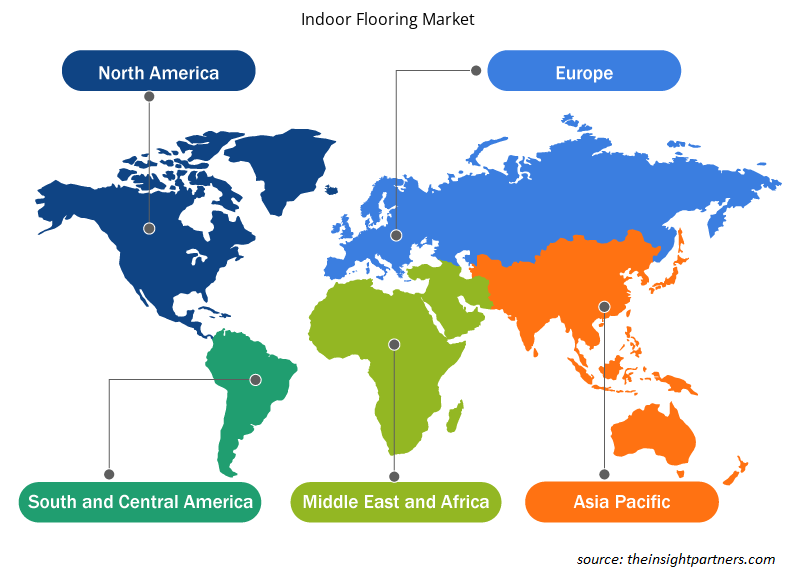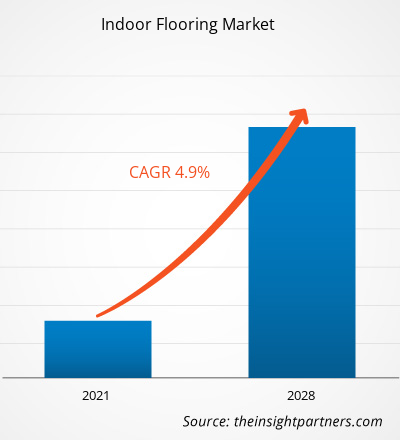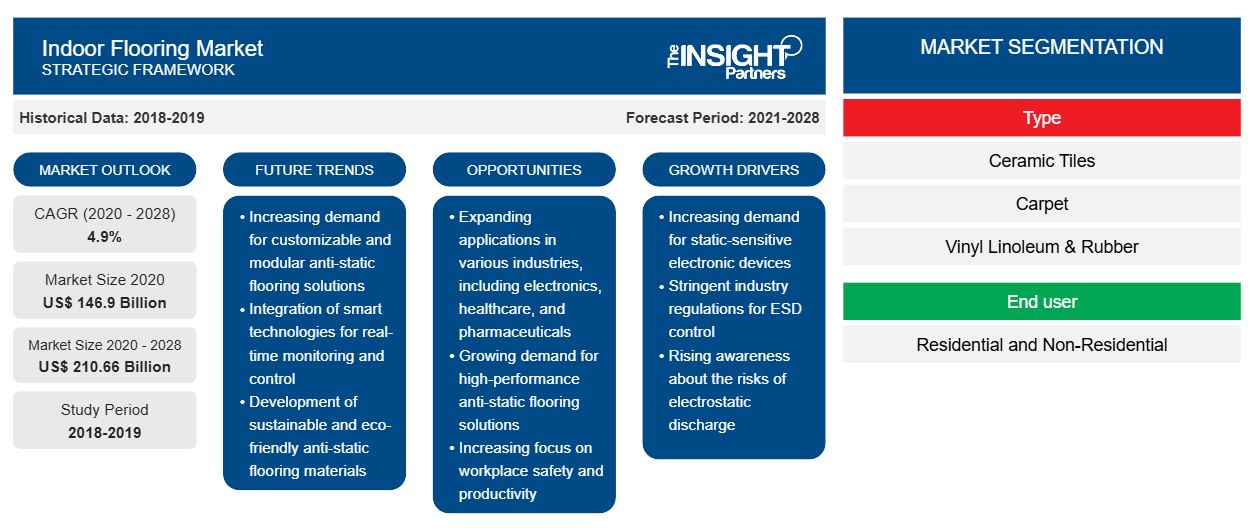[연구 보고서] 실내 바닥재 시장은 2020년에 1,469억 달러 규모로 평가되었으며, 2021년부터 2028년까지의 예측 기간 동안 4.9%의 CAGR로 성장할 것으로 추산됩니다.
창고, 비행기 격납고, 조립 공장, 도장 공장, 차체 공장, 유통 시설 등의 산업 현장에서 콘크리트 바닥은 가혹하고 부식성 있는 화학 물질과 오일에 노출되어 마모되고 파손될 수 있습니다. 또한 비행기나 지게차 등 무거운 기계와 장비로 인한 긁힘과 마모로 인해 손상될 수도 있습니다.
APAC 개발도상국의 제조 및 가공 공장의 급속한 산업화와 설립은 바닥 코팅에 대한 수요를 견인하고 있으며, 제약, 식품 및 음료, 자동차 조립 산업이 주요 수요 창출원입니다. 유럽과 미국의 다국적 기업은 중국과 인도와 같은 APAC 개발도상국에서 사업을 확장하고 있습니다. 유명 제조업체가 이 지역 국가에 운영 시설을 설립함에 따라 산업용 바닥 코팅에 대한 수요도 증가하고 있습니다. 수요 증가로 인해 실내 바닥재 시장 도금업체가 고급 및 일반 제품을 도입하여 실내 바닥재 시장을 견인하게 되었습니다.
귀하의 요구 사항에 맞게 이 보고서를 사용자 정의하세요
이 보고서의 일부 또는 국가 수준 분석, Excel 데이터 팩을 포함하여 모든 보고서에 대한 사용자 정의를 무료로 받을 수 있으며 신생 기업 및 대학을 위한 훌륭한 혜택과 할인 혜택을 이용할 수 있습니다.
-
이 보고서의 주요 시장 동향을 알아보세요.이 무료 샘플에는 시장 동향부터 추정 및 예측까지 다양한 데이터 분석이 포함됩니다.
COVID-19 팬데믹이 실내 바닥재 시장에 미치는 영향
COVID-19 발발은 인프라 개발과 세계 경제에 상당한 영향을 미쳤습니다. 주요 인프라 부문과 산업의 급속한 혼란에 대한 국제적 대응이 계속되고 있습니다. 세계보건기구의 최신 상황 보고서에 따르면 미국, 인도, 브라질, 러시아, 영국, 프랑스, 스페인, 이탈리아는 COVID-19 발발로 인해 가장 큰 피해를 입은 국가에 속합니다. 이 발발은 2019년 12월 우한(중국)에서 처음 시작되었으며 그 이후로 전 세계로 확산되었습니다. COVID-19 위기는 전 세계 산업에 영향을 미쳤습니다. 세계 경제는 2020년에 부정적인 영향을 받았으며 2021년에도 계속될 것으로 보입니다. 이 팬데믹은 전 세계의 실내 바닥재 사업체와 공급업체에 혼란을 초래했습니다. 시장 참여자들은 운영에 혼란을 겪었으며 2021년 중반까지 결과에 직면할 가능성이 높습니다. 공장 폐쇄, 무역 금지, 국경 봉쇄는 실내 바닥재 산업에 부정적인 영향을 미쳤습니다. 반면에 시장은 2021년에 개장하여 가까운 미래에 인기를 얻을 것으로 예상됩니다.
실내 바닥재 시장 통찰력
스포츠 단지에서 바닥 코팅 사용 증가
실내 및 실외 스포츠 경기장에 사용되는 바닥 코팅 시스템은 뛰어난 점탄성, 미끄럼 방지, 표면 탄성 및 반발력과 같은 특성의 올바른 조합이 필요합니다. 또한 일반적으로 사용되는 착색 재료 및 첨가제와의 우수한 광학적 특성과 호환성을 보이는 동시에 매우 내구성이 있어야 합니다. 고성능 폴리우레탄 바닥 코팅은 표면에 뛰어난 탄성과 좋은 그립감을 부여하는 동시에 선수들이 민첩하게 움직이고 코트에서 능숙하게 움직일 수 있게 해주므로 실내 스포츠 홀, 테니스, 배구 및 농구 코트, 레슬링 및 체조 홀의 바닥 코팅에 선호되는 재료입니다. 스포츠 단지와 경기장을 건설하는 정부와 민간 건설 회사의 지출이 증가함에 따라 도시와 교외 지역에 수많은 스포츠 시설이 개발되었으며, 이는 향후 몇 년 동안 특수 고성능 실내 바닥재에 대한 높은 수요를 창출할 가능성이 높습니다.
유형 기반 시장 통찰력
실내 바닥재 시장은 유형에 따라 세라믹 타일, 카펫, 비닐 리놀륨 및 고무, 목재 및 라미네이트, 기타로 분류됩니다. 세라믹 타일 세그먼트는 실내 바닥재 시장을 지배했습니다. 세라믹 타일은 주택, 병실 및 화장실의 바닥을 강화하는 데 널리 사용됩니다. 이들은 시장에서 광범위하게 판매됩니다. 세라믹은 도자기라고도 합니다. 세라믹 타일은 바닥재와 벽에도 사용됩니다. 이들은 질감, 패턴 및 크기에 따라 광범위한 종류로 제공됩니다. 글로벌 및 로컬 시장에서 많은 업체가 다양한 유형의 관련 제품을 제공합니다.
실내 바닥재 시장에서 활동하는 업체들은 시장에서의 입지를 유지하기 위해 합병, 인수, 시장 이니셔티브와 같은 전략에 집중합니다. 주요 업체들의 몇 가지 개발 사항은 다음과 같습니다.
- 2020년 주 및 지방 경제 개발 소식통에 따르면 Shaw Industries Group은 링골드에 새로운 공간을 짓기 위해 2,000만 달러를 투자했습니다. 이 회사는 2021년 6월 1일경에 링골드에 있는 새로운 공간을 차지할 계획입니다.
- 2018년 Interface는 고무 바닥재 회사 인수로 성능 바닥재 분야로 사업 영역 확장
실내 바닥재 시장 지역 통찰력
Insight Partners의 분석가들은 예측 기간 동안 실내 바닥재 시장에 영향을 미치는 지역적 추세와 요인을 철저히 설명했습니다. 이 섹션에서는 북미, 유럽, 아시아 태평양, 중동 및 아프리카, 남미 및 중미의 실내 바닥재 시장 세그먼트와 지리에 대해서도 설명합니다.

- 실내 바닥재 시장에 대한 지역별 특정 데이터 얻기
실내 바닥재 시장 보고서 범위
| 보고서 속성 | 세부 |
|---|---|
| 2020년 시장 규모 | 1,469억 달러 |
| 2028년까지 시장 규모 | 2,106억 6,000만 달러 |
| 글로벌 CAGR (2020-2028) | 4.9% |
| 역사적 데이터 | 2018-2019 |
| 예측 기간 | 2021-2028 |
| 다루는 세그먼트 |
유형별로
|
| 포함된 지역 및 국가 |
북아메리카
|
| 시장 선도 기업 및 주요 회사 프로필 |
|
실내 바닥재 시장 참여자 밀도: 비즈니스 역학에 미치는 영향 이해
실내 바닥재 시장은 소비자 선호도의 변화, 기술 발전, 제품의 이점에 대한 인식 증가와 같은 요인으로 인해 최종 사용자 수요가 증가함에 따라 빠르게 성장하고 있습니다. 수요가 증가함에 따라 기업은 제품을 확장하고, 소비자의 요구를 충족하기 위해 혁신하고, 새로운 트렌드를 활용하여 시장 성장을 더욱 촉진하고 있습니다.
시장 참여자 밀도는 특정 시장이나 산업 내에서 운영되는 회사나 기업의 분포를 말합니다. 주어진 시장 공간에 얼마나 많은 경쟁자(시장 참여자)가 존재하는지 그 규모나 총 시장 가치에 비해 나타냅니다.
실내 바닥재 시장에서 활동하는 주요 회사는 다음과 같습니다.
- 포보 인터내셔널 SA
- 주식회사 매츠
- 타켓
- 암스트롱 플로링 주식회사
- 보리유 인터내셔널 그룹
면책 조항 : 위에 나열된 회사는 어떤 특별한 순서에 따라 순위가 매겨지지 않았습니다.

- 실내 바닥재 시장의 주요 업체 개요를 알아보세요
글로벌 실내 바닥재 시장은 다음과 같이 세분화됩니다.
글로벌 실내 바닥재 시장 – 유형별
- 세라믹 타일
- 양탄자
- 비닐 리놀륨 및 고무
- 목재 및 라미네이트
- 기타
글로벌 실내 바닥재 시장 – 최종 사용자별
- 주거용
- 비주거용
글로벌 실내 바닥재 시장 – 지리별
-
북아메리카
- 우리를
- 캐나다
- 멕시코
-
유럽
- 프랑스
- 독일
- 이탈리아
- 러시아 제국
- 영국
- 유럽의 나머지 지역
-
아시아 태평양(APAC)
- 중국
- 인도
- 일본
- 호주
- 대한민국
- APAC의 나머지 지역
-
중동 및 아프리카(MEA)
- 사우디 아라비아
- 아랍에미리트
- 남아프리카 공화국
- MEA의 나머지
-
남미 및 중미(SCAM)
- 브라질
- 아르헨티나
- 나머지 SCAM
회사 프로필
- 포보 인터내셔널 SA
- 주식회사 매츠
- 타켓
- 암스트롱 플로링 주식회사
- 보리유 인터내셔널 그룹
- 에코어 인터내셔널
- 인터페이스 주식회사
- 톨리코퍼레이션
- 모호크 인더스트리 주식회사
- 쇼 인더스트리 그룹 주식회사
- 과거 분석(2년), 기준 연도, CAGR을 포함한 예측(7년)
- PEST 및 SWOT 분석
- 시장 규모 가치/거래량 - 글로벌, 지역, 국가
- 산업 및 경쟁 환경
- Excel 데이터세트
최근 보고서
사용 후기
구매 이유
- 정보에 기반한 의사 결정
- 시장 역학 이해
- 경쟁 분석
- 고객 인사이트
- 시장 예측
- 위험 완화
- 전략 기획
- 투자 타당성 분석
- 신흥 시장 파악
- 마케팅 전략 강화
- 운영 효율성 향상
- 규제 동향에 발맞춰 대응























 무료 샘플 받기 - 실내 바닥재 시장
무료 샘플 받기 - 실내 바닥재 시장